“],”filter”:{“nextExceptions”:”img, blockquote, div”,”nextContainsExceptions”:”img, blockquote, a.btn, a.o-button”},”renderIntial”:true,”wordCount”:350}”>
Every fall, my family piled into our station wagon and set out from suburban Boston to view the foliage in northern New England. I still have a shoebox full of the home movies my father shot on those weekend outings; the grainy, jouncy footage shows a succession of white band stands, weathered barns, mom-and-pop roadside motels, and my sister doing cartwheels in swirls of falling leaves.
Even then, I got the message that while New Hampshire and Maine were indeed pretty (and, bonus points, had amusement parks with trained bears and pet-able deer), Vermont—pristine, billboard-free, and broad-vistaed—was the gold and orange and crimson standard of leaf peepery. It turns out it wasn’t just my family’s opinion. There’s solid science to back that up.
Things to Know About Vermont’s Fall Foliage
A combination of factors makes Vermont foliage hard to beat in North America, according to William Keeton, a professor of forest ecology and forestry at the University of Vermont, in Burlington. For starters, more than three-quarters of the state is forested—and one out of four trees are showoff-y maples. A riot of species comprise the other 75 percent.
“We have such diversity here: American beech, yellow and paper birch, red oak, white ash, poplars, willows, aspen, alder, and others—and they each yield different colors,” Keeton says. “Then there’s the diversity of the topography, with different elevations and aspects and landforms, and different climate conditions that influence foliage timing and intensity. The result is a mosaic of color that’s quite breathtaking.”
This magic triggers in late summer by the onset of cooler nights and shorter days, signaling chlorophyll, the green pigment that allows trees to create energy from light, to dissipate. When it does, the leaves’ true colors emerge in what Keeton calls “the great reveal.”
Vividness varies from year to year, depending on rainfall, temperatures, and other factors leading up to the season. While scientists are concerned that climate change may be leading to a dulling, shortening, or shifting of the foliage period, they admit that the exact recipe for optimal color remains a mystery.
“That’s part of what makes it so fun and exciting,” Keeton says. “We never know how it’s going to play out.”
What is certain is that the technicolor wave starts in northern Vermont in the highest elevations around mid-September and and ends in the valleys in the southern part of the state sometime in mid-to-late October. You can watch it as it unfolds with a fall foliage tracker or you can just get in the car and drive. Here are nine of the most beautiful places to check out Vermont’s big show.
If you buy through our links, we may earn an affiliate commission. This supports our mission to get more people active and outside. Learn more.
1. Underhill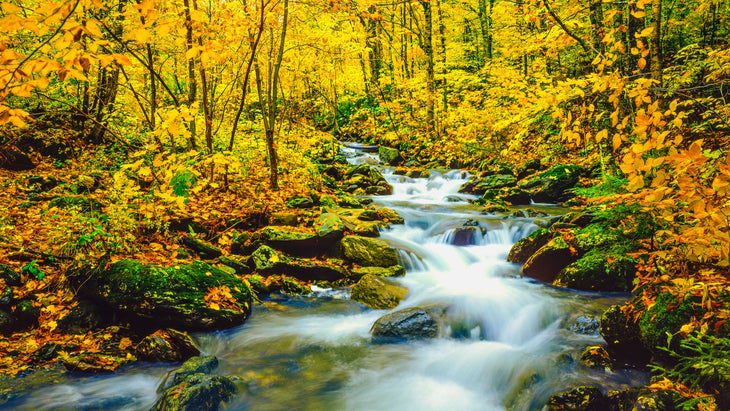 Underhill’s Browns Creek cascades alongside vivid autumn colors in Vermont. (Photo: Getty/Ron and Patty Thomas)
Underhill’s Browns Creek cascades alongside vivid autumn colors in Vermont. (Photo: Getty/Ron and Patty Thomas)
You could join the masses in Stowe and ascend Mount Mansfield, Vermont’s highest peak, by car, gondola, or foot. But for a less congested approach, consider starting in Underhill, on the mountain’s western flank. A rewarding roughly five-mile loop follows the Frost Trail to the more challenging Maple Ridge Trail and a rocky scramble up to Mansfield’s “Forehead,” then descends via the mellower Butler Lodge Trail through hardwood forest. Find more bliss back in Underhill’s Pleasant Valley, where a 20-mile gravel and paved bike loop winds through a wonder of silo-studded farmland backed by Mansfield’s snaking ridgeline.
⭐ Don’t Miss: Poorhouse Pies, a self-service bakery near Underhill Center, selling sweet (maple cream!) and savory (pulled pork mac-n-cheese!) pies.
Book Airbnbs in Underhill
2. Shelburne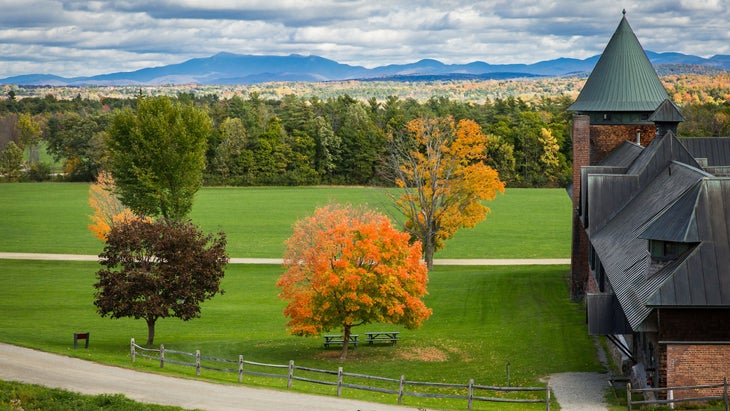 The view of Camel’s Hump from Shelburne Farms’ 19th-century Farm Barn on a gorgeous fall day. (Photo: Courtesy of Shelburne Farms)
The view of Camel’s Hump from Shelburne Farms’ 19th-century Farm Barn on a gorgeous fall day. (Photo: Courtesy of Shelburne Farms)
Shelburne Farms, a 1400-acre education nonprofit, was founded by a Vanderbilt heir in the late 19th century as an agricultural showplace. Walk the pastoral grounds along the Lake Champlain shoreline and past the grand estate house turned inn, and visit the Farm Barn, where cheesemakers produce award-winning cheddar (my go-to is their clothbound variety) with milk from the resident Brown Swiss herd. Then head south to hundred-year-old Mount Philo State Park and its diminutive 968-foot namesake peak. The summit trail was recently improved with stone stairways; the killer view of farms, Lake Champlain, and the Adirondacks remains the same.
⭐ Don’t Miss: The ridgetop Yates Family Orchard, in nearby Monkton, for you-pick apples and their signature Dreamee, that is, maple soft serve ice cream atop a warm cider donut.
Book Airbnbs in Shelburne
3. East Burke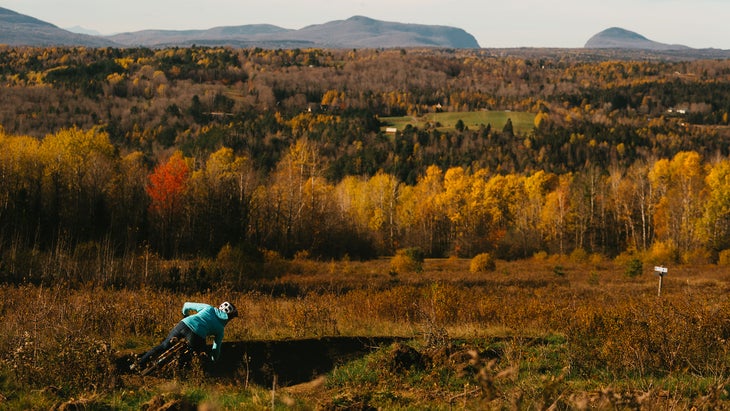 A Kingdom Trails’ rider shreds a berm on the Dashney Loop with the Willoughby Gap in the background. (Photo: Mark Clement)
A Kingdom Trails’ rider shreds a berm on the Dashney Loop with the Willoughby Gap in the background. (Photo: Mark Clement)
The renowned Kingdom Trails 100-mile mountain bike network, carved out of private land in the state’s rugged Northeast Kingdom, celebrates its 30th anniversary with three new trails in the Kitchell area, including Drop It!, a triple black diamond with jumps and drops. When and if you’re ready to get off the bike, make the 15-mile drive north to cold, deep Lake Willoughby, a fjord-like glacial gash between the sheer flanks of Mount Pisgah and Mount Hor; trails on both peaks lead to magnificent overlooks.
❗Know Before You Go: Most of the bike center’s trails and roads damaged by two bouts of flooding rains in July have been repaired, but check KingdomTrails.org for updates.
Book Airbnbs in Burke
4. Waitsfield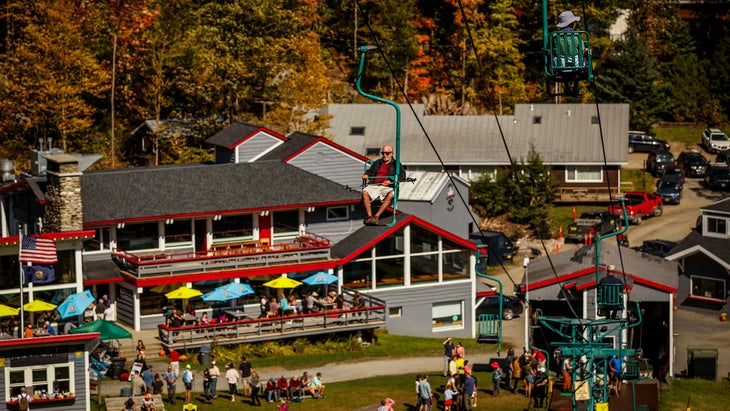 The base lodge and iconic single chairlift at Mad River Glen open to foliage viewers for three weekends in the fall. (Photo: Courtesy of Kintz)
The base lodge and iconic single chairlift at Mad River Glen open to foliage viewers for three weekends in the fall. (Photo: Courtesy of Kintz)
The funky, slow 1948 single chairlift at the co-op-owned Mad River Glen ski area cranks up for foliage viewing on three consecutive weekends starting September 28 and costs just $20 ($15 for kids and seniors) to partake. Once you reach the summit, head north or south for an out-and-back ramble on the ridgeline Long Trail. For a different perspective on the Mad River Valley, make your way to nearby Fayston to saddle up for a Vermont Icelandic Horse Farm guided trail ride (from $133) on country roads and through open meadows.
⭐ Don’t Miss: Lawson’s Finest Liquids, just off Route 100, serving stellar IPAs, including their flagship Sip O’ Sunshine, in a soaring post-and-beam taproom with a mountain-view outdoor patio.
Book Airbnbs in Waitsfield
5. Windsor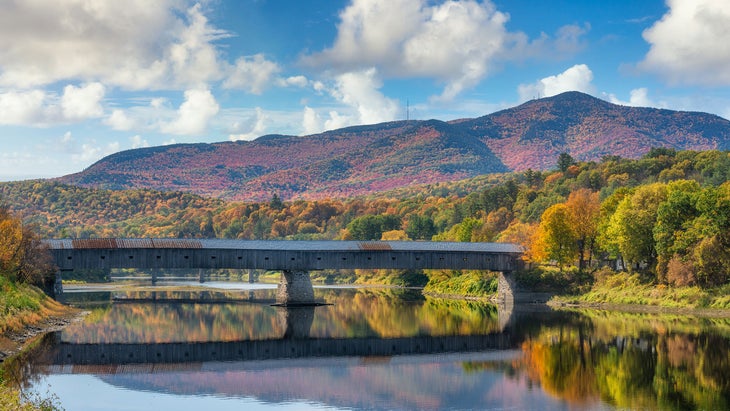 Autumn view of the Cornish-Windsor Bridge, the longest wood-covered span in the U.S. (Photo: Getty/Craig Zerbe)
Autumn view of the Cornish-Windsor Bridge, the longest wood-covered span in the U.S. (Photo: Getty/Craig Zerbe)
Mount Ascutney, an isolated 3,144-foot monadnock, dominates the landscape in the Upper Valley of the Connecticut River, where I live. You can pedal or drive the narrow 1930s Mount Ascutney Parkway or hike the five-mile round-trip Weathersfield trail to get to the top, but since the summit is mainly forested, you’ll want to climb the 25-foot observation tower for the 360-degree, Green and White Mountains panorama. Back in the valley, book a self-guided canoe or kayak trip with Great River Outfitters; they’ll shuttle you and your chosen craft to a put-in on the broad Connecticut (from $43).
⭐ Don’t Miss: The 1866 Cornish-Windsor bridge, the longest wooden covered span in the United States, connecting Vermont to New Hampshire.
Book Airbnbs in Windsor
6. Woodstock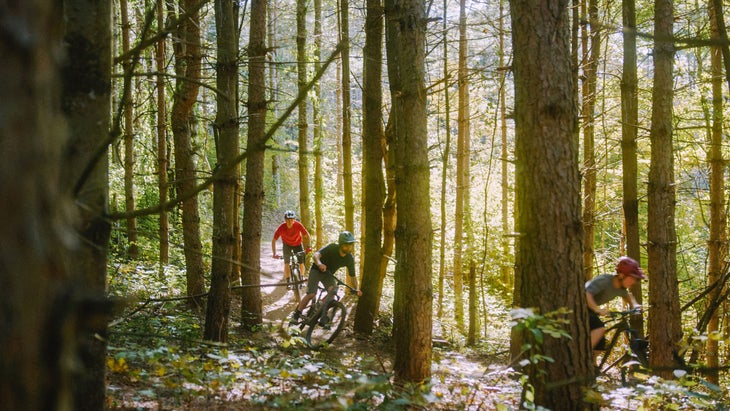 Finding the flow in the forest on the Mount Peg’s mountain bike trails during early fall. (Photo: Courtesy of Woodstock Inn & Resort)
Finding the flow in the forest on the Mount Peg’s mountain bike trails during early fall. (Photo: Courtesy of Woodstock Inn & Resort)
With its flawless brick-front shops and whitewashed historic homes, Woodstock is la-la land Vermont. And sometimes that’s what you want—even if it means dodging tour groups. I like to take in the tidy village from the top of Mount Tom, either by hustling up the heavily used Faulkner Trail or by taking the longer Pogue route, which begins on Victorian-age carriage roads in Marsh-Billings-Rockefeller National Historical Park. Mount Peg, another in-town peak, has 16 miles of woods and meadow trails co-managed by the Woodstock Area Mountain Bike Association and the Woodstock Inn and Resort, where you can spend the night. (Rooms from $669).
❗Know Before You Go: After being overrun by social media followers vying for shots of the ridiculously scenic Sleepy Hollow Farm, Cloudland Road is closed from September 25 through October 16 to all but residents.
Book Airbnbs in Woodstock
7. Manchester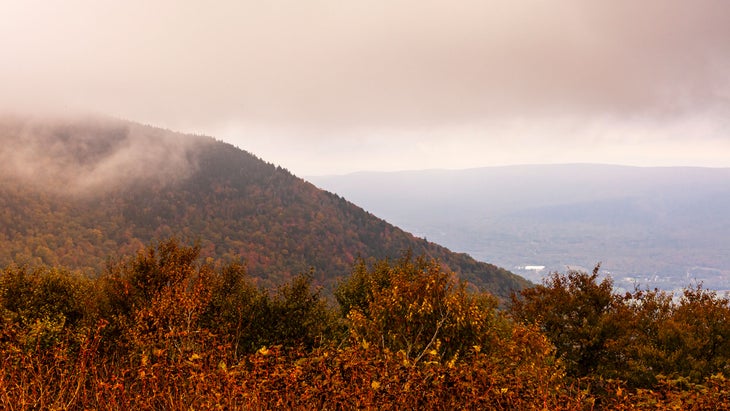 Scenic autumn views from Mount Equinox viewpoint during a moody morning. (Photo: Getty/David Robinson)
Scenic autumn views from Mount Equinox viewpoint during a moody morning. (Photo: Getty/David Robinson)
Stately 19th century homes, flanked in the west by soaring 3,848-foot Mount Equinox, the highest peak in the Taconic range, and yes, a strip of designer apparel outlet stores, make this southern Vermont shire town a hot spot for visitors. You can drive to the top of Equinox on the serpentine five-mile toll road or hike up on the relentlessly steep Blue Summit trail through forests of beech, yellow birch, and maple. For more level miles, walk the landscaped grounds of Hildene, the 1905 summer estate of Robert Todd Lincoln, Abraham Lincoln’s son and the president of the Pullman Palace Car Company.
❗Know Before You Go: Hildene’s Many Voices exhibit chronicling the lives of the Black Pullman porters is the southernmost stop on the African American Heritage Trail, which takes you to historical and cultural sites that explore the stories of Black Vermonters.
Book Airbnbs in Manchester
8. Bennington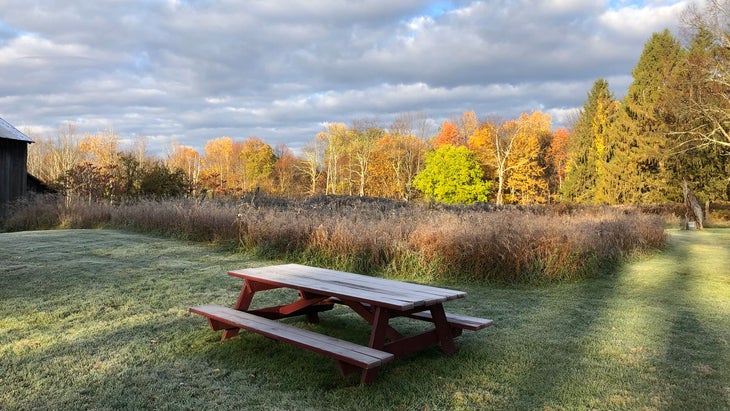 Mid-October on the pretty (name-appropriate) grounds of the Robert Frost Stone House Museum. (Photo: Courtesy of the Robert Frost Stone House Museum)
Mid-October on the pretty (name-appropriate) grounds of the Robert Frost Stone House Museum. (Photo: Courtesy of the Robert Frost Stone House Museum)
It’s no surprise that this is Robert Frost country; the poet is buried in the Old First Church cemetery near the curved white picket fences and stately homes of sugar maple-lined Monument Avenue. A 20-mile loop drive through North Bennington and Shaftsbury takes you past Frostian covered bridges and old stone walls. Make time to stop at the Robert Frost Stone House Museum, the poet’s home for most of the 1920s, where readings, lectures and workshops are held throughout the fall. . From there, the gently sloping two-mile Robert Frost trail traverses his old apple orchard and leads to Lake Paran, with inspiring views along the way of the Berkshires, Taconics, and Greens.
⭐ Don’t Miss: The classic 1948 Blue Benn Diner, saved from post-Covid closure by a nostalgic Bennington College alum. The menu features lots of vegetarian options, but let’s be honest, post-leaf-peeping moments usually call for a Reuben.
Book Airbnbs in Bennington
9. Newfane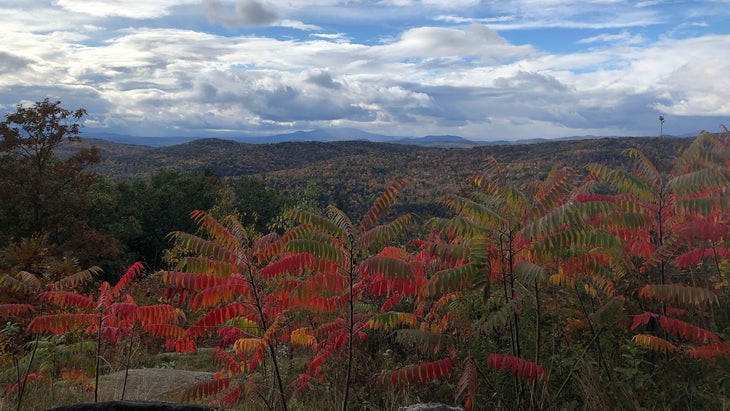 Colors popping in the trees and ferns along Windmill Ridge just outside of Newfane, VT (Photo: Benjamin Tepler)
Colors popping in the trees and ferns along Windmill Ridge just outside of Newfane, VT (Photo: Benjamin Tepler)
The town green in this tiny village is at the center of an extraordinary collection of architectural gems, including a columned Greek Revival courthouse and inn, two imposing Gothic Revival churches, and a brick Romanesque bank. Grab snacks at the 1822 Newfane Country Store, then head east to the Putney Mountain trailhead for a low-key woodland stroll or run to the wide-open summit. You’ll have the company of birdwatchers participating in the annual Hawk Watch; every autumn, thousands of migrating hawks and other raptors can be seen riding the ridgeline thermals.
❗Know Before You Go: Newfane’s adorableness peaks on October 12 and 13 during its 53rd Heritage Festival, when local volunteers sell (by the slice or whole) the more than 200 apple pies they baked for the occasion.
Book Airbnbs in Newfane
Source link : http://www.bing.com/news/apiclick.aspx?ref=FexRss&aid=&tid=66f56322a6f54a19a379451a1b087276&url=https%3A%2F%2Fwww.outsideonline.com%2Fadventure-travel%2Fdestinations%2Fnorth-america%2Fvermont-fall-foliage%2F&c=6448879807090227916&mkt=en-us
Author :
Publish date : 2024-09-25 23:00:00
Copyright for syndicated content belongs to the linked Source.